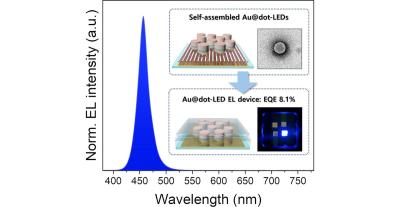Researchers from Korea's Kookmin University in collaboration with colleagues from Kyung Hee University have managed to enhance the performance of microLEDs produced using fluidic self-assembly based on chelation bonds of chemical linkers. The researcher report up to 61.8% increase in assembly yield compared to previous methods, and their vertically assembled 1.3 um microLEDs achieved a peak EQE of 8.1% and a brightness of 22,300 nits at 9 V.
The researcher developed a novel approach for the face-selective vertical assembly of microLEDs using a chemical linker capable of engaging in metal chelate coordination interactions within Zn metal complexes.
The new process has three steps. First, gly-thiol (a chemical linker) is used to treat the deposited Au layer on the p-GaN surface of the microLEDs and the lower Au electrode using a self-assembly (SAM) method. In the second step, various zinc precursors are applied to the gly-thiol-treated bottom Au electrode to form metal chelate coordination bonds. Finally, the gly-thiol-treated microLEDs undergo vertical self-assembly via the chelate bond.


